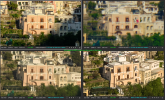I've had this screenshot sitting on my desktop for a while now, figured this is as good a time as any to share it. All images were taken within a few minutes.
The top left image was taken with my Fujifilm X-T3 with 55-200mm lens @ 150mm from 1500m distance.
The top right image was taken with my Fujifilm X-T3 with 55-200mm lens @ 300mm from 3500m distance.
Obviously, the image taken at 1500m is much better than the image taken at 3500m.
The bottom left image was taken with the Mavic 3 tele lens @ 162mm from 1300m. The Fuji is the clear winner here, which makes sense because the lens alone weighs almost as much as the drone!
Finally, the bottom right image was taken with the Mavic 3 wide lens @ 24mm from only 300m distance. The clear overall winner imo. Not that surprising but it was interesting to see how much effect distance has.

The top left image was taken with my Fujifilm X-T3 with 55-200mm lens @ 150mm from 1500m distance.
The top right image was taken with my Fujifilm X-T3 with 55-200mm lens @ 300mm from 3500m distance.
Obviously, the image taken at 1500m is much better than the image taken at 3500m.
The bottom left image was taken with the Mavic 3 tele lens @ 162mm from 1300m. The Fuji is the clear winner here, which makes sense because the lens alone weighs almost as much as the drone!
Finally, the bottom right image was taken with the Mavic 3 wide lens @ 24mm from only 300m distance. The clear overall winner imo. Not that surprising but it was interesting to see how much effect distance has.










